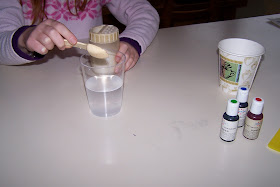We used 4 clear plastic cups, 2 foam cups, 2 pipettes (called for 1 eyedropper and 1 pipette), salt, 1 tsp measuring spoon, smidge of cardboard, a pencil, staples and food coloring (the paste-type as that's what we own)-------in addition to hot and cold water, of course LOL
Salinity-dependent layering:
Daisy first made some green salt water.
We created a pouring stick by pushing the tip of a pencil through a small cardboard circle. The cardboard was held under the liquid in the cup while plain cool water was poured down the pencil, so that no uncolored water splashed into the colored water. I couldn't get a picture of this process as I was the pourer. After the water was poured in, we could see two distinct layers simulating two ocean layers separated by salinity.
Then Daisy took a piece of foam cup and added staples, one by one, to it. It took many, many stapes for the piece to eventually sink to the boundary between the two layers. I didn't get a picture because my silly camera ate the batteries. By the time I had changed them, Daisy had fished the foam piece out to add more staples so that it sank all the way to the bottom of the cup.Temperature-dependent layering:
Using the pouring stick technique, Daisy combined cool blue water and hot red water to simulate ocean layers separated by their temperatures.
Creating an underwater waterfall:
Daisy began with cool water in a clear cup. Hot, salty red water was mixed up in another cup. She carefully filled a pipette and squeezed a layer of red water onto the surface of the cool water.
The red layer began to form tiny "waterfalls" within the clear water as the red layer cooled. At first, the hot red layer was less dense than the cooler clear water but became more dense as it cooled.
Observing underwater springs:
We needed really salty water for this demonstration!
After 15 minutes or so, the layers of the underwater waterfall demonstration (red, third from left) had pretty much disappeared but all others remained long enough to show off to Older Brother after school.
To quote Bill Nye, "Science rules!"










OH WOW Science does rule. You have such detail in your pics and she looks as if she had so much fun!
ReplyDelete